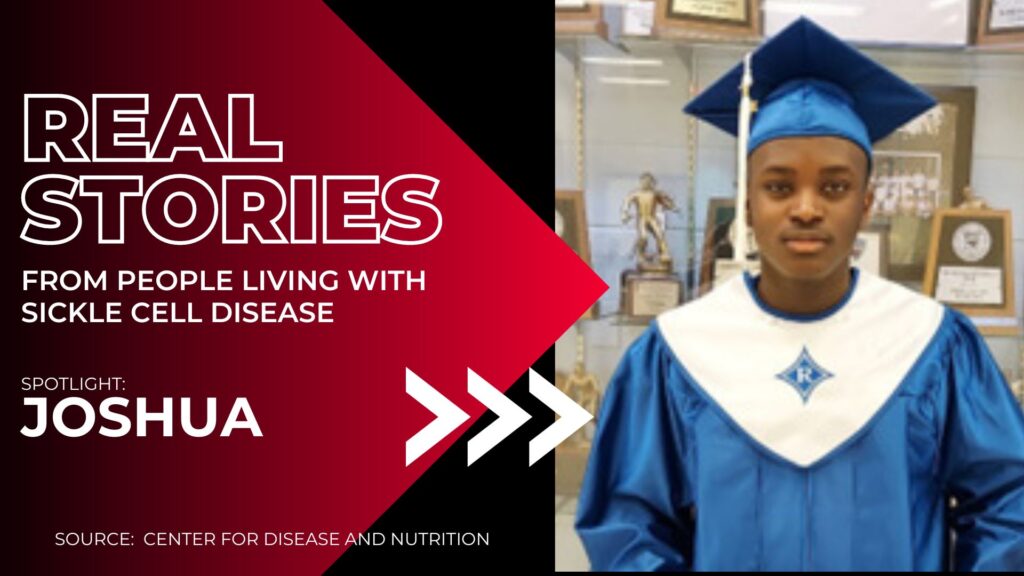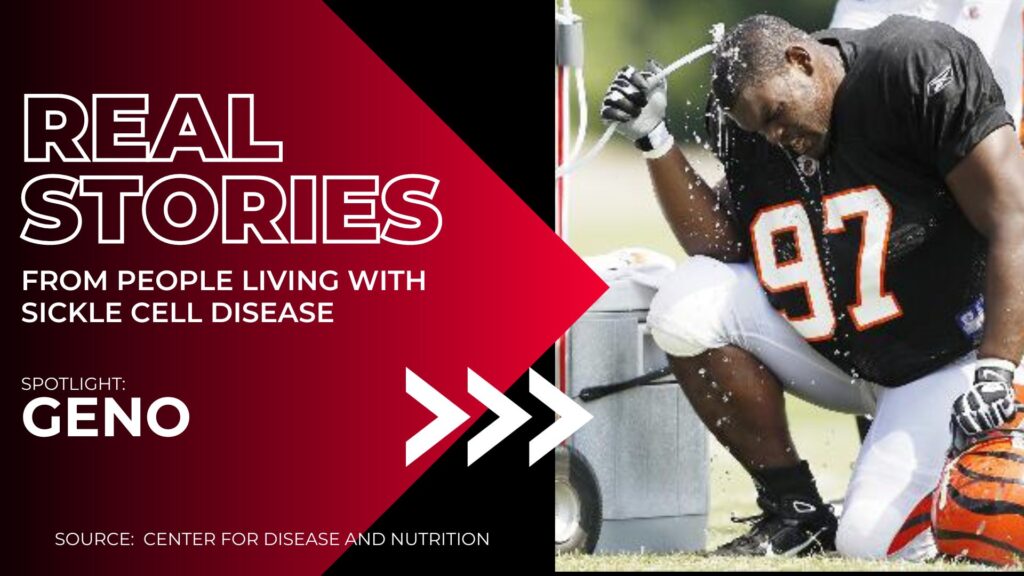Real Stories from People Living with Sickle Cell Disease: Joshua

Joshua’s Story
Joshua Adekunle is a high school senior who likes to play video games, draw, craft, and learn new things. He excels in school and takes honors and advanced placement classes to constantly challenge himself. He was born with sickle cell disease (SCD), but he never lets his condition affect who he is or limit who he can become.
Joshua’s parents learned he had SCD through a newborn screening test at birth. Joshua’s dad knew he had sickle cell trait (SCT) before getting married. Joshua’s mom learned while she was pregnant that she also had SCT. SCT occurs when a person has one sickle cell gene and one normal gene. When both parents have SCT, there is a 1 in 4 (25%) chance that any child of theirs will have SCD.
Learning to Manage SCD
When Joshua was younger, he didn’t really understand what SCD was. He often had pain episodes (also known as pain crises) but thought they were just something that happened to him. As he got older, he realized he was having pain because of SCD and that it was a genetic disease that he would have to learn to manage and live with. Over time, he’s learned how to manage his SCD and who to share information with about his disease. Experience has taught him how important it is to inform his teachers and school administrators of his condition so they can help him avoid situations that might trigger pain for him.
When Joshua was a freshman in high school, SCD made it hard for him to participate in contact sports. Instead, he joined the marching band to stay active and involved. He played the cymbals and sometimes a light-weight drum called a snare because he knew his limitation in carrying heavy instruments. One winter, his school participated in his city’s Christmas parade that was held outdoors in the city’s downtown area. For the parade, he was set to play the cymbals, but on the day of the parade, some students didn’t show up and the band director asked Joshua to play the bass drums instead. The director was unaware of Joshua’s SCD at the time. Although Joshua was concerned about carrying and marching with the heavy bass drums during the parade, he decided to do it anyway. About halfway through the parade, Joshua started to experience a pain crisis. The bass drums were heavy and straining his back. He nearly collapsed on the street and had to get medical help immediately. This experience taught Joshua a valuable lesson about how sharing his condition with school staff can help him stay healthy.
SCD Complications
As a toddler, Joshua took penicillin to help treat his SCD-related complications. When he got a little older, he started taking hydroxyurea (a medicine to help treat and prevent SCD complications). Over the years, Joshua has had many surgeries because of his SCD. He’s had to have both his left and right hips replaced because of avascular necrosis (AVN), which is when bone tissue dies from lack of blood flow. He also had his gallbladder (a small, pear-shaped organ located under the liver) removed to treat gallstones. Having numerous surgeries may not be common among other teenagers, but Joshua doesn’t think about it too much. The surgeries help him stay healthy and have allowed him to appreciate life.
One of the worst complications that he’s faced so far is the pain he had when he got COVID-19 in 2020. It was the worst pain he had ever felt in his life. He was admitted to his local hospital, and while the hospital staff did everything that they could to try to help him feel better, nothing seemed to work. He was transferred to Duke University Hospital, about an hour away, because Duke specializes in SCD care. At Duke, Joshua was in the intensive care unit (ICU) for 3 days and stayed in the hospital for an additional month for treatment to recover from COVID-19. The virus took a toll on his physical health, and the stress on his body affected his coordination. He had trouble walking and moving, and he needed physical therapy to relearn how to walk. It was a difficult time for him, but he was able to overcome the difficulties and regain his health. It took about 3–4 months for Joshua to fully recover from COVID-19.
Support and Community
Family has always been Joshua’s support system. Growing up, he never knew anyone else living with SCD. He thought SCD was something that no one else would be able to understand or relate to. That changed when he went to “Victory Junction,” a summer camp for children with chronic diseases. At camp, he was able to meet other children in his cabin who, like him, were living with SCD. One night while talking with his new friends about SCD, he finally felt like he could relate to others. “I was finally able to share some of my experience and share what the pain is like and the types of restrictions the pain can put on you.”
Bone Marrow Transplant
A bone marrow transplant replaces unhealthy blood stem cells (special cells that develop into different types of blood cells, such as red blood cells) in the bone marrow with healthy blood stem cells from a matched donor (a person with similar, compatible bone marrow). In people with SCD, their bone marrow makes abnormal, C-shaped red blood cells; but after a bone marrow transplant, their body may potentially be able to make healthy red blood cells.
In 2018, Joshua underwent surgery for a total hip replacement in his left hip at Duke University Hospital. There, he learned that he was eligible for a bone marrow transplant through a program at Duke. The transplant could potentially cure his SCD. While Joshua and his family were learning more about the transplant and the process of getting into the program, they tested his younger brother to see if he was a match. They were elated to learn that he was. In 2021, Joshua was able to have the transplant procedure and received bone marrow from his brother. One of the hardest parts of the transplant was the chemotherapy Joshua had to get before the transplant procedure. “I remember learning about chemotherapy in school, but actually going through it was tough,” said Joshua.
Despite the challenges, Joshua remained positive. He worked hard to stay on top of his schoolwork during chemotherapy and while he recovered from the transplant. He was in the hospital for about 3 months for chemotherapy and continued home care and follow-up appointments with his doctors after the transplant procedure. Even during recovery, Joshua kept himself busy. He studied, took online classes, took photography lessons, and stayed active to help speed his recovery.
After the transplant, Joshua hasn’t experienced any symptoms of SCD, such as pain crises, but he is still dealing with symptoms of AVN that affected his health before the transplant. His shoulders are showing signs of AVN, and he may need shoulder replacement surgery in the future.
Goals and Moving Forward
As for next steps after high school, Joshua is planning to attend the University of North Carolina at Chapel Hill and later applying to medical school to continue his studies.
“Getting a bone marrow transplant was my awakening in figuring out what kind of career I wanted. I want to go for a type of career that can help other people with conditions like me. I’m thinking of going into medical research or becoming a physician to help combat genetic diseases like mine,” said Joshua.
Tips for Others
When asked what tips he has to offer others, Joshua shared, “Just try to remain hopeful. You know your situation. Try not to let SCD limit you in any way. It can limit you physically, but as long as you have a good mindset, you can stay grateful.”
Recommend0 recommendationsPublished in CDC Content, Real Stories from the CDC





Responses